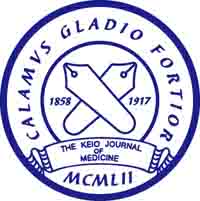[Advanced Published online The Keio Journal of Medicine, by J-STAGE]
<Title:> Regenerative Therapy for Patients with Congenital Heart Disease
<Author(s):> Naritaka Kimura
<Corresponding author E-Mill:> naritaku(at)keio.jp
<Abstract:> Congenital heart disease (CHD) is the most common birth defect, affecting 1 in 100 babies. Among CHDs, single ventricle (SV) physiologies, such as hypoplastic left heart syndrome and tricuspid atresia, are particularly severe conditions that require multiple palliative surgeries, including the Fontan procedure. Although the management strategies for SV patients have markedly improved, the prevalence of ventricular dysfunction continues to increase over time, especially after the Fontan procedure. At present, the final treatment for SV patients who develop heart failure is heart transplantation; however, transplantation is difficult to achieve because of severe donor shortages. Recently, various regenerative therapies for heart failure have been developed that increase cardiomyocytes and restore cardiac function, with promising results in adults. The clinical application of various forms of regenerative medicine for CHD patients with heart failure is highly anticipated, and the latest research in this field is reviewed here. In addition, regenerative therapy is important for children with CHD because of their natural growth. The ideal pediatric cardiovascular device would have the potential to adapt to a child’s growth. Therefore, if a device that increases in size in accordance with the patient’s growth could be developed using regenerative medicine, it would be highly beneficial. This review provides an overview of the available regenerative technologies for CHD patients.
<Keywords:> regenerative therapy, congenital heart disease, stem cell, heart failure
<URL:> https://www.jstage.jst.go.jp/article/kjm/advpub/0/advpub_2018-0002-IR/_html


![COVID-19: Stay Cool toward Corticosteroids [Published online in advanced , by J-STAGE]](http://kjm.pupu.jp/blog/wp-content/uploads/2020/05/2020-0007-LE-100x100.jpg)
![Clinical Significance of Right Ventricular Function in Pulmonary Hypertension [Published online in advanced , by J-STAGE]](http://kjm.pupu.jp/blog/wp-content/uploads/2021/01/2020-0015-IR-100x100.jpg)
![Concerns Associated with Uterus Transplantation in Japan [Published online Keio J Med, 70, 68-71, by J-STAGE]](http://kjm.pupu.jp/blog/wp-content/uploads/2021/09/KJM_logo-100x100.jpg)
![Long-term Spontaneous Partial Regression of a Cerebral Arteriovenous Malformation: 24-Year Follow-up [Published online Keio J Med, 66, 51-53, by J-STAGE]](http://kjm.pupu.jp/blog/wp-content/uploads/2017/09/2016-0010-CR-100x100.jpg)
![Vitamin D Deficiency with High Intact PTH Levels isMore Common in Younger than in Older Women:A Study of Women Aged 39 64 Years [Published online in advanced , by J-STAGE]](http://kjm.pupu.jp/blog/wp-content/uploads/2016/02/2015-0010-OA-100x100.jpg)
![Age Group Differences in Daily Life Changes among Community Residents during the COVID-19 Pandemic: A Pilot Study on Intergenerational Comparison [Published online Keio J Med, 72, 11-20, by J-STAGE]](http://kjm.pupu.jp/blog/wp-content/uploads/2023/03/2022-0007-OA-100x100.jpg)
![Leadership Training of Surgery in US [Published online Keio J Med, 66, 54-54, by J-STAGE]](http://kjm.pupu.jp/blog/wp-content/uploads/2017/09/66-004-ABST-100x100.jpg)
![Multiple Mutations within Individual Oncogenes: Examples and Clinical Implications [Published online Keio J Med, 72, 88-92, by J-STAGE]](http://kjm.pupu.jp/blog/wp-content/uploads/2023/09/2022-0026-OA-100x100.jpg)
![Targeting DNA Methylation in Podocytes to Overcome Chronic Kidney Disease [Published online Keio J Med, 72, 67-76, by J-STAGE]](http://kjm.pupu.jp/blog/wp-content/uploads/2023/09/2022-0017-IR-100x100.jpg)
![Coagulation Assay and Stroke Severity upon Admission of Patients with Cardioembolic Cerebral Infarction during Direct Oral Anticoagulant Use [Published online Keio J Med, 70, 93-99, by J-STAGE]](http://kjm.pupu.jp/blog/wp-content/uploads/2021/12/2020-0019-OA-100x100.jpg)